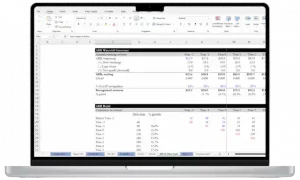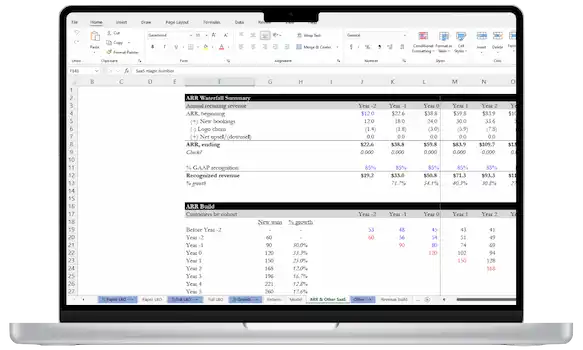A company cannot improve its unit economics if it doesn’t accurately understand them … that’s where customer lifetime value comes in.
It’s useful because some companies are not profitable overall (e.g. due to overhead expenses), but once you dig under the hood, it is profitable at the customer level.
Customer lifetime value can be simultaneously one of the most important metrics for assessing the strength of an SaaS company, and the hardest to assess.
How do you find what a customer is worth to the company? Customer Lifetime Value is here to answer the question.
What Is Customer Lifetime Value in SaaS?
Customer Lifetime Value (LTV) is a measure of how valuable a specific customer (or set of customers) has been, or will be, to the company over the course of their entire relationship.
It is based on two key metrics:
- Longevity with the customer to the company
- How much value they bring in revenue (or contribution margin) every month
A customer who stays with the company for a year will have a lower lifetime value than one who stays for two or five, at the same subscription level.
A customer who maintains a $200 per month subscription will have a higher lifetime value than one who pays $20.
Clearly, the ideal customer is one who maintains a high price point (and profitability) and who remains loyal with low churn to the company for several years.
Luckily for SaaS companies, it is often the large enterprise clients who do fit that description, and this is why SaaS companies often seek out these companies with a high potential LTV.
How to Calculate Customer Lifetime Value in SaaS
We’ve already looked at the two metrics that determine a customer’s lifetime value – average revenue per user (ARPU) and lifetime value.
For the “average customer”, lifetime value may be hard to estimate, as different customer groups may have a wide range of customer lifetimes.
Therefore, there are two possible ways to calculate LTV:
- One that can be used generally, for the entire company’s customer base
- One that can be used for specific customers or cohorts of customers
If you want to calculate a general LTV across your customer base, you can do it this way:
LTV = ARPU x Company Gross Margin % / Average Company Churn Rate
If you want to calculate LTV for a specific customer account, you can do this instead:
LTV = Customer ARR x Customer Gross Margin % x Customer Lifetime
Of course, if you have the analytics, you can drill into your LTV calculations across different sectors of your customer base. Different customer sectors are going to have different churn rates, different average contract values, and will have different levels of commitment to your company and your product.
Customer lifetime value with negative churn
Larger, well-established SaaS companies with a negative churn rate (new revenue is greater than revenue lost each month) also will need a different calculation method to calculate LTV.
This is because negative churn would result in an infinite LTV, which is clearly not realistic. In these situations, you also have to include a discount rate to account for the decreased value of future revenue.
Customer Lifetime Value Calculation Example
For clarity purposes, we’ll stick to a simple example.
Let’s look at two different customers.
The first is an average customer in a B2C segment of the company. They spend $25 per month on their subscription, are reasonably happy with their use of the software, and have been using the product for a year.
The second is a B2B client. They use the software extensively in their business and have been using your software for five years. They have a subscription to your software for $100/month.
In both cases, the company’s gross margin is 80%.
The LTV of the first client avatar would be $300 x 0.8 x 1 = $240 LTV.
The LTV of the second client avatar would be $1200 x 0.8 x 5 = $4,800 LTV.

- 33 lessons
- 8+ video hours
- Excels & templates
What is a “good” LTV for SaaS?
It’s difficult to say what the ideal LTV for a company is, since it will vary so much based on their specific product, industry, etc.
Rather than look at the absolute value, it can be more useful to think of the LTV on a relative basis, specifically in comparison to CAC (customer acquisition cost).
To this end, the LTV-to-CAC ratio is considered the gold standard of calculating unit economics, and it needs to remain at a healthy level.
By comparing the LTV to the CAC (customer acquisition cost), it helps you understand to what degree a company’s investment to find new customers is paying off.
LTV-to-CAC ratio for SaaS
A company can afford to spend more in customer acquisition costs in order to attract customers with a high LTV.
There is no benefit in spending a large amount of money in acquiring new customers that will churn or barely recoup the cost of their acquisition cost in their time with your company.
Instead of looking at LTV alone to create a strategic growth plan for your company, you can make better decisions by combining LTV with CAC to determine marketing budget, pricing concerns, ideal customer avatars, and more.
Most investors and entrepreneurs target an LTV-to-CAC ratio of higher 3x, but this depends on the stage of the company, circumstances, etc.
This means that the customer would bring at least 3x times more value to the company than the company spent to acquire them.
How to increase customer lifetime value for SaaS
Higher customer lifetime value is dependent on finding and satisfying the right customers. Take a look at your existing customer base. If you have the analytics for it, filter your customers to see what you can uncover about their LTV’s.
First, filter for highest recurring revenue or subscription cost. Then, sort by age of customer. This will give you your highest-LTV customers.
Which customer profiles have the highest LTV? Those are the ones you should try to replicate via new marketing and try to nurture through customer success efforts.
Business clients often have higher subscription budgets than consumers. Their conversion cost to switch to a new software is also much higher than for individuals, meaning that it is more difficult for them to leave.
See if you can find out how you acquired those customers. Was it through Google ads? LinkedIn? Organic SEO?
Now you know that these are the marketing channels that brought you your most valuable clients – this is where you should focus your marketing and sales budget. Bear in mind your CAC – you have a larger acquisition cost budget with higher LTV clients, but don’t go overboard.
Interview them if you can to find out what these customers like best about your service. These features are what you should focus on in developing and improving your offering.
Below these higher-level strategies, focus on:
- Decreasing churn
- Increasing revenue for all users
To decrease churn, focus on customer satisfaction, downgrading memberships rather than leaving altogether, and making sure customers understand the full value of your services. Instituting an exit survey for customers who do churn can make it easier to mitigate churn in the future.
Increasing revenue can be trickier. You can upsell and cross-sell to make each customer more valuable, but it’s also important to consider pricing. If you consistently have lower LTV’s than your competitors, you may be underpricing yourself. Raising prices on existing customers can be a delicate business, but under some circumstances, it may be the right choice to maintain a healthy customer value for the company.
Next steps
For a deeper dive, go to my full SaaS metrics breakdown or check out my full online course on SaaS metric and financial modeling. These are critical skills to know as a growth, venture, or even private equity investor!


 SaaS & Growth Metrics
SaaS & Growth Metrics Break Into Growth Equity
Break Into Growth Equity
